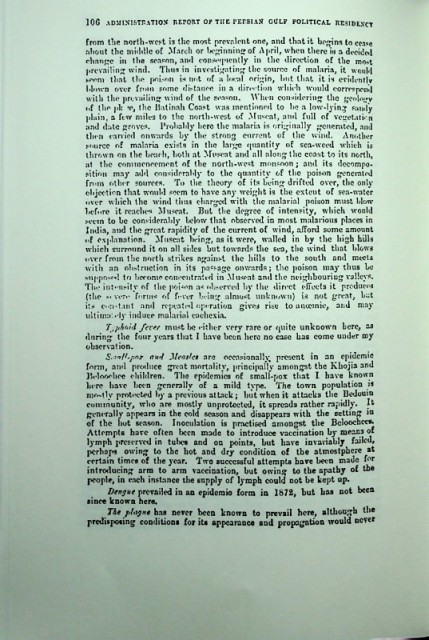Page 354 - PERSIAN GULF ADMINISTRATION REPORTS V1
P. 354
10G ADMINISTRATION RETORT OF THE PERSIAN CULP POLITICAL RESIDENCY
from tlic north-west is the most prevalent one, and that it begins to cense
about the middle of March or beginning of April, when there is a decided
change in tlie season, and consequently in the direction of the mo>t
prevailing wind. Thus in investigating the source of malaria, it would
scorn that the poison is not of a local origin, hut that it is evidently
blown over from some distance in a direction which would correspond
with the prevailing wind of the season. When considering the geology
of the pi: •(», the IJatinah Coast was mentioned to be a low-lying sandy
plain, a few miles to the north-west of Muscat, and full of vegetation
and date groves. Probably here the malaria is originally generated, and
then carried onwards by the strong current of the wind. Another
source of malaria exists in the large quantity of sea-weed which is
thrown on the beach, both at Muscat and all along the coast to its north,
at the commencement of the north-west monsoon; and its decompo
sition may add considerably to the quantity of the poison generated
from other sources. To the theory of its being drifted over, the only
objection that would seem to have any weight is the extent of sea-water
over which the wind thus charged with the malarial poison must blow
before it reaches Muscat. But the degree of intensity, which would
seem to be considerably below that observed in most malarious places in
India, and the great rapidity of the current of wind, afford some amount
of explanation. Muscat being, as it were, walled in by the high hills
which surround it on all sides but towards the sea, the wind that blows
over from the north .strikes against the hills to the south and meets
with an obstruction in its passage onwards; the poison may thus be
supposed to become concentrated in Muscat and the neighbouring valleys.
The intensity of the poison as observed by the direct effects it produces
(the >• vore forms of fever bring almost unknown) is not great, but
its c-'U'tant and repeated operation gives rise to anceinie, and may
ultimately induce malarial cachexia.
Tjpho'ul fever must he cither very rare or quite unknown here, as
during the four years that I have been here no case has come under my
observation.
S-nall-por aw! JHeatfc* are occasionally; present in an epidemic
form, and produce great mortality, principally amongst the Khojia and
Bcloochce children. The epidemics of small-pox that I have known
lure have been generally of a mild type. The town population is
mostly protected by a previous attack; but when it attacks the Bedouin
community, who are mostly unprotected, it spreads rather rapidly. It
generally appears in the cold season and disappears with the setting iu
of the hot season. Inoculation is practised amongst the Beloochccs.
Attempts have often been made to introduce vaccination by means of
lymph preserved in tubes and on points, but have invariably failed,
perhaps owing to the hot and dry condition of the atmostphere at
certain times of the year. Two successful attempts have been made f°r
introducing arm to arm vaccination, but owing to the apathy of the
people, in each instance the supply of lymph could not be kept up.
Dengue prevailed in an epideraio form in 1872, but has not been
since known here.
The plague has never been known to prevail here, although the
predisposing conditions for its appearance and propagation would never

